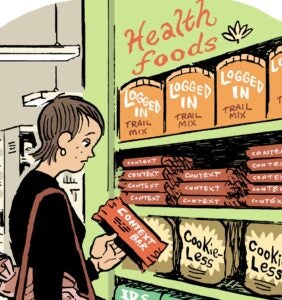The direct-to-consumer food space is hugely competitive.
You’ve got the meal kit delivery guys such as Hello Fresh, Plated and Sun Basket; the online grocery delivery folks, including FreshDirect and Peapod from Stop & Shop; and Grubhub, DoorDash and Uber Eats for people who can’t be bothered with meal prep.
And then there’s Hungryroot, a New York City-based healthy grocery service that personalizes the items its sends to people based on a survey they take about their dietary preferences.
But how does Hungryroot differentiate from the crowd?
“I get that question all the time,” said CEO Ben McKean, who founded the company in 2014 after a two-year stint as VP and general manager of Groupon’s food and beverage category. McKean took the job after selling his restaurant-booking startup, Savored, to Groupon in 2012.
The answer, McKean said, is through a mixture of personalization and convenience. Although there’s been innovation around the cooking-meals-at-home aspect of the food industry, the larger opportunity in his view is the convenience of having quick and healthy meals or snacks on the go.
“That category has actually seen very little innovation, and the incumbents – Kraft Heinz, General Mills, Pepsi – have been around for a very, very long time,” McKean said. “But if you can build a DTC brand for healthy, convenient food, I think you’ve got something.”
AdExchanger spoke with McKean.
AdExchanger: How do you think about growth and acquisition?
BEN MCKEAN: We’re a subscription service, which means that our real growth opportunity comes from retention, not acquisition. If our retention is higher, our customers are valuable and more likely to refer others, and the better our retention, the higher cost-per-acquisition we’re able to afford.
We’re always asking ourselves: Who does our service work best for? Which demos? Men or women? Which age groups? People with different dietary restrictions? Is someone interested because they want to spend less time cooking or because they want to lose weight? By answering these questions, we figure out who our most valuable customers are, and then we can think about targeting, channels and creative messaging.
Are you thinking about how to expand your acquisition efforts to reach prospects that aren’t all that health conscious yet?
If someone is skeptical about eating plant-based food [which Hungryroot has a lot of] or having fresh food delivered to them, the best way to convince them otherwise is for them to hear it from a friend or family member who’s also a Hungryroot customer. It’s referrals and word of mouth. That’s how we think about broadening the impact of our marketing.
How does Hungryroot approach marketing?
It’s been a challenge, and that’s because when we first launched this business we positioned as a better-for-you packaged food company. We had six products. We started expanding into more products, like a healthier version of cookie dough, which is still one of the most popular things we offer, but the customer experience wasn’t what it needed to be.
Part of the reason why there aren’t that many DTC brands [that focus on a specific food item]: Consumers want a one-stop shop for their food purchases. The consumer experience of going to a site that offers, say, 10 or 15 products, isn’t very compelling. Who wants to go to one website to buy yogurt, another to buy pasta and a third to get the sauce? That was an important early learning for us.
With that in mind, what ingredients go into Hungryroot’s marketing strategy?
 Our strategy has evolved significantly over the past five years as we’ve focused on being a grocery service. That is the notion that fuels our marketing. Today, we have around 100 products we’ve developed and done the R&D on in house, and we supplement them through partnerships with other brands, like Beyond Meat, Banza and Kite Hill.
Our strategy has evolved significantly over the past five years as we’ve focused on being a grocery service. That is the notion that fuels our marketing. Today, we have around 100 products we’ve developed and done the R&D on in house, and we supplement them through partnerships with other brands, like Beyond Meat, Banza and Kite Hill.
Facebook and Instagram have become our primary paid channels, both because they fit in with the visual nature of our product, and because that’s where we can find our core demographic of women between the ages of 25 and 50. Those are also the two criteria we look for in any channel we test.
On the non-paid side, referrals is our second-biggest channel, which makes sense. Food can be a deeply personal experience, and if people have a good experience, it’s something they want to talk about.
How do you personalize the product experience?
Personalization is related to a customer problem or need. Some people love walking through the aisles or searching between hundreds of different products online to fill their empty cart. But that can become cumbersome, especially if you have some sort of dietary restriction or diet objective.
A significant segment of the market just wants to outsource that entire experience to a service that understands who they are, what they need, the types of food they like and dislike. People create a profile and we select items we think they’d like. They can edit this later to say whether they do or don’t want certain items – information we can also use to try and get better the next time.
On top of that, when customers state their preferences it also provides us with an incredibly data-rich feedback mechanism that we can use to make our products better.
Can you share an example of that?
One has to do with how we market our tofu products. We found that when we included the word ‘tofu’ in the name of a product, customers were less excited about it. It’s an interesting insight into consumer psychology, the fact that calling something “yuba noodles” rather than “tofu noodles” can have a material impact on the initial appeal of a product and even how much someone enjoys it.
This interview has been edited and condensed.















